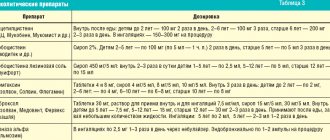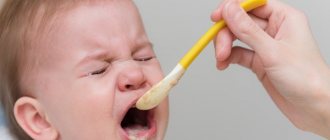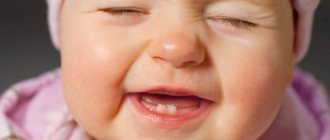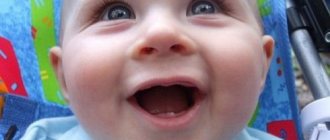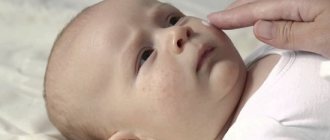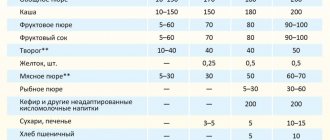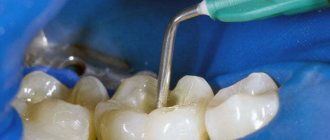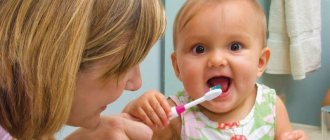In the first months of life, liquid stool is normal for babies. But sometimes there are disturbances in the functioning of the intestines, externally manifested in the form of diarrhea. Malfunctions in the gastrointestinal tract in an infant can lead to dire consequences. Therefore, it is necessary to be attentive to all unusual manifestations in the bowel movements of infants. What to do if a 3-month-old child has diarrhea?
What is constipation?
Experts diagnose constipation if the baby does “big” things:
- regularly and without problems, but at the same time dry and hard feces are released;
- with difficulty - the child has to push, feces do not come out on the first try;
- less than 5 times a day.
In the first six months of life, constipation is a rather rare occurrence; rather, on the contrary, in the period from 0 to 6 months, 6–10 bowel movements per day is considered the norm. In breastfed children, defecation occurs more often, in bottle-fed children - less often.
First aid for food poisoning in children
First aid for moderate to severe food poisoning is gastric lavage. In children, it is better not to carry out this procedure on your own, but to seek help from specialists. Typically, washing is done with a solution of sodium bicarbonate or potassium permanganate until the wash water is clean. It is strictly forbidden to wash the stomach of children under one year of age on their own. The child may choke. Children who have been poisoned by chemicals (alkalies or acids) and plants whose juice can cause burns should not be rinsed. When they pass through the digestive tract again, in the opposite direction, they will again damage the mucous membrane.
The next step in case of food poisoning, or in a situation where it is mild, is the use of adsorbents. These are substances that collect toxins and poisons that enter the body on their surface. There are two basic rules for using such drugs. The medicine should be taken fractionally: often and in small portions. This way he will be able to collect the maximum amount of toxin. The use of the adsorbent should be short-term. No longer than 4-5 days. Long-term use of such drugs in infants leads to excessive compaction of stool and the formation of fecal impaction. Diarrhea may give way to painful constipation. A very important point in treatment is unsoldering a child, especially a small child. For infants, frequent breastfeeding and additional water are recommended. There are special solutions to replenish fluid loss. They are sold in the form of powders that are diluted with water. By consuming them, the child replenishes the loss of not only fluid, but also microelements and sugars. After 3 years, even drinking with plain water, weak tea, or compote is quite effective. According to recent clinical studies, the use of antibiotics and antiseptics for toxic infections is not effective. During the recovery period, adherence to a diet is important - eating easily digestible food in small portions. Adding vitamins and microelements.
First aid for poisoning with chemicals and poisons should be carried out by specialists. In such cases, antidotes are used.
If botulism is suspected, doctors use antitoxic serum.
Constipation is rare before 6 months
Usually, parents of babies in the first months of life are concerned about the opposite of constipation - too frequent bowel movements. But in a baby, regardless of whether he is fed breast milk or formula, the intestines should work exactly like this - in a mode that is considered diarrhea for older children and adults.
There should be no other option, at least until complementary feeding is introduced at 4–6 months. After all, the baby receives mostly liquid food, the waste of which has the same consistency and leaves the intestines without encountering any obstacles on the way - the baby has not yet learned to control the sphincter, which restrains the release of feces.
The baby’s intestines have just begun to “get acquainted” with microorganisms that come from the mother’s milk, from her skin (the baby licks the nipple), and from the environment. Not all new “partners” are accepted: there are some who are rejected, who don’t take root, and so on. Inspection and rejection are accompanied by loose, unstable stools.
Too frequent bowel cleansing does not need correction or treatment if the child is gaining weight and developing correctly. Normal appetite and sleep, gas, absence of fever and other signs of illness indicate that parents have nothing to worry about. If the baby’s mother, tired of changing diapers 10 times in one day, wants to change the situation and asks the doctor to prescribe strengthening medications for the baby, then, without wanting to, she will doom her baby to chronic constipation.
Release forms and price category
No-spa is available in the form of tablets, as well as in ampoules for intramuscular and intravenous administration. The dosage of one tablet is 40 mg of drotaverine hydrochloride. The tablets have a yellowish-greenish color and are bitter to taste. On one side there is a marking with the inscription “spa”. There are blisters of 6 and 24 pieces. For larger quantities, bottles with stoppers are used, which have 60, 64, 100 pieces. Ampoules are available in two milliliters. The amount of drotaverine per 1 ml of solution is 20 mg; only 2 ml of solution contains 40 mg of drotaverine hydrochloride. The ampoules are made of dark glass and have a marked break point for ease of opening.
No-spa is available in the form of tablets and ampoules.
The drug is affordable. It all depends on the manufacturer, but in any case, no-silo can be classified as a budget drug.
Not according to the rules
And yet, in the first 6 months, constipation in infants is not excluded. They can call him:
- microflora transmitted from mother;
- insufficient fluid volume;
- stress.
Let's say a woman has too many bacteria in her stomach and intestines that produce methane, which causes constipation. They grow rather slowly, ferment, releasing carbon dioxide, which promotes flatulence and bloating. The woman lives with this deviation, has adapted and learned to solve the problem with the intestines in one way or another. Noticing the same thing in the child, she decides that the baby has inherited her characteristics and “saves” him using the same means, making a mistake. Babies should not be given laxatives, especially those containing senna. The baby’s body gets used to such drugs too quickly and can no longer cleanse the intestines without them.
Constipation in a baby under 6 months is also caused by a lack of fluid and hormonal changes. At 6 months, the baby should receive a lot of moisture - approximately 140 ml per kilogram of weight per day. A breastfed baby gains this amount from mother's milk and does not need additional sources of fluid (but only if there is no predisposition to constipation). Little artificial babies are given extra food from the moment they switch to formula.
If a woman is tense or nervous, her level of the stress hormone cortisol increases. The substance enters the baby's body through breast milk, saliva or sweat and also causes constipation.
Even if the mother does not breastfeed, microorganisms that cause constipation sooner or later reach the baby’s gastrointestinal system and produce negative changes in it.
Possible consequences of food poisoning in children
As a rule, food poisoning, although it has clear symptoms, ends quickly and without consequences. Usually, by 3-4 days the child feels much better. In rare cases, young children may go into shock as a result of acute fluid loss. Children with severe underlying chronic pathology may develop severe inflammation.
Things are somewhat more complicated with poisoning by chemicals and poisons. If assistance is not provided in a timely manner or if there is a large amount of toxic substance, damage to the gastrointestinal tract, central nervous or cardiovascular system may persist. Their severity depends on many factors.
Botulism is a dangerous disease. According to modern literature, up to 10-20% of cases are fatal. Complications from the nervous system are common.
Constipation after introducing complementary foods
The baby is growing, improving his skills, and it’s time to introduce him to new foods. These circumstances, on the one hand, help to establish peristalsis, and on the other, increase the risk of constipation.
By six months, the baby is already trying to control bowel movements, because he has realized that unpleasant sensations appear after it - itching, burning and other discomfort in the areas where feces fall. In order not to experience discomfort, the child tries to restrain the urge. At first he fails to do this, because the rectum has already learned to work - to reflexively contract and push out waste. And after a couple of months everything works out, the baby wins and starts on the path leading to chronic constipation. To take the child beyond this vicious circle, the mother must minimize the duration of contact of the baby’s skin with feces and expand his diet by introducing complementary foods.
Proteins, fats and carbohydrates included in foods are absorbed in the small intestine, but do not reach the large intestine, where feces are formed. The same cannot be said about fiber. While the baby drinks breast milk or formula, this component of the dish is unfamiliar to him. Even if a nursing woman herself eats a lot of plant foods, the baby gets nothing. Fiber, as already noted, is not absorbed in the intestines, does not enter the blood, which means it is not in breast milk. For the first time, the baby receives fiber with complementary foods, trying his first 25 grams of pureed zucchini, carrots and other vegetables. Plant fibers literally attract all waste, resulting in the formation of feces, which help the intestines master proper peristalsis. In this section of the gastrointestinal tract, in the intestines, there are many muscles, they must learn to consistently contract - tense and relax - in order to squeeze waste out.
The next new product should be introduced a month after the previous one. The new product will likely cause more frequent and loose stools at first. If it is not green and does not foam, there is no need to run to the doctor and ask to prescribe fixatives. Be patient, after a while the innovation will be mastered and bear fruit. Instead of liquid and shapeless yellow-white feces, you will see formed brown feces.
Teething: how to help your baby?
When do the first teeth appear?
The timing of teething in children can vary significantly.
They depend on the physical constitution of the child, the nature of his nutrition, individual characteristics and inherited genetic parameters. On average, teething begins at 6–8 months of life. However, for some babies, the first tooth may appear at 4 months or even earlier, while for others it may appear closer to a year. For some children, teeth erupt painlessly, without causing much concern. But most babies experience discomfort at this time. The child may become capricious, irritable, wake up periodically at night, and refuse to eat. The most common warning signs of teething are excessive salivation, redness and swelling of the gums, and itching in the gums. The baby may also experience increased body temperature and diarrhea.
What are these problems associated with and how to alleviate the child’s condition during teething?
Increased salivation during teething
Excessive salivation is due to the fact that growing teeth irritate the nerve receptors of the salivary glands, and they begin to show their activity. As a rule, drooling appears 4-6 weeks before tooth eruption. Due to excessive saliva production, the baby may develop redness on the skin around the lips and on the chin. To avoid this, wipe your child's face with a soft cloth throughout the day. If irritation already exists, you can lubricate the skin in this area with baby cream or cream containing dexpanthenol while the baby is sleeping.
Pain syndrome during teething
The sharp edge of the tooth, breaking through the sensitive gum tissue, irritates the nerve endings and causes unpleasant pain in the baby. It is because of this that the child becomes capricious and irritable. At night, as a rule, the pain syndrome is more pronounced, and therefore the baby may often wake up at night. During this period, you should try to give the baby as much attention, affection and care as possible. You can try to distract your baby from “dental problems” with a new bright toy or rattle. It is also advisable to maintain the child’s usual routine, not introduce new complementary foods, and not do vaccinations.
If pain during teething is severe, you can use special gum gels with an analgesic effect. These products contain the anesthetic lidocaine, which has a local anesthetic effect. The gels may also contain chamomile extract, which has an anti-inflammatory effect. A small amount of gel (the size of a small pea) should be applied to a clean finger and gently rubbed into the area where the tooth is erupting. This procedure is carried out after meals and before the baby goes to bed. Gels can be used a maximum of 6 times a day with breaks of at least 3 hours.
Gel in tube “Kamistad Baby”, 10 g
You can try giving your baby a gentle gum massage. To do this, gently massage the child’s gum with a clean finger or gauze swab dipped in boiled cool water. Pressure on the gums during massage reduces pain.
Itching during teething
Many mothers notice that with the beginning of the appearance of the first teeth, the child began to put everything in his mouth. He does this to scratch the irritated gum. If you look into your baby's mouth, you will see that the gums above the erupting tooth are red and swollen. To help relieve itchy gums, there are special teethers available. They can be made of silicone or food grade rubber. Some of them contain liquid filler – water. Before giving such a teether to your baby, you can cool it in the refrigerator for 20 minutes (not in the freezer!). Cold soothes itching, relieves swelling of the gums, reduces inflammation and relieves the baby from discomfort.
Increase in temperature during teething
There is a widespread belief among parents that the appearance of teeth in a baby is accompanied by an increase in temperature. In fact, this is not always the case. Fever during teething is usually associated with a weakening of the body's defenses, decreased immunity and a viral infection entering the child's body. Thus, if the baby’s temperature rises, you should call a doctor and rule out all acute conditions. If the doctor is sure that the child does not have any infectious process, then an increase in temperature to 37.5 ° C can be considered the result of gum inflammation.
If the temperature rises above 38.5 °C, antipyretics based on paracetamol or ibuprofen can be used to reduce it. These drugs can be given to babies in strictly age-appropriate dosages.
Stool disorder
During teething, many babies experience loose stools. There may be several reasons. Firstly, it is the swallowing of large amounts of saliva and increased peristalsis; secondly, decreased immunity and disruption of intestinal microflora. If an infection occurs, the child may experience diarrhea. In this case, the stool becomes watery and happens more than 4 times a day. To clarify the diagnosis, the baby should be shown to a doctor.
Refusal to eat
During teething, some babies may be reluctant to eat or refuse to eat at all. This is due to the fact that when feeding, the feeling of pain and discomfort in the gums increases. There is no need to try to force feed your baby: the appetite will be restored immediately after teething.
Caring for your first teeth
Immediately after the first teeth appear, they need to be properly cared for. It is important to remember that one single tooth needs the same careful care as thirty-two. First, parents brush their child’s teeth without toothpaste: the baby will need it after 1–1.5 years, when the teeth have fully erupted and are visible above the surface of the gums.
The easiest way to care for your first teeth is to use a piece of gauze. Wrap your index finger in gauze soaked in warm boiled water and gently wipe the child’s gums. This procedure can be carried out no earlier than 30 minutes after eating to avoid regurgitation.
You can also use a special silicone brush that is placed on the parent’s finger. This brush is a transparent cap, at the end of which there are many short silicone hairs or pimples. Using this device, you can remove plaque from the first teeth and massage your baby’s gums. After cleaning, the brush should be washed with soap and rinsed thoroughly with warm water.
To care for the oral cavity of babies, you can use special wipes. They are impregnated with a solution containing xylitol, which prevents the growth and development of bacteria that cause caries.
At about 1 year of age, when the child has already erupted 8-10 baby teeth, you can start brushing his teeth with a toothbrush. The bristles on a baby's toothbrush should be soft so as not to injure his teeth and gums. It should be made of synthetic material - polyester. This is due to the fact that natural bristles are difficult to dry and germs accumulate in them more quickly. When choosing toothpaste for children, you need to look at the age indicated on the package. The main rule is that the paste should not contain fluorides. Children under 3–4 years of age often swallow toothpaste, and fluoride is a toxic substance for the child’s body.
Children's toothpaste "Asepta Baby" from 0 to 3 years, 50 ml
Gel paste for protecting the first teeth from bottle caries and preventing inflammatory diseases of the baby’s oral mucosa.
More details >
When the child turns 1 year old, he needs to be seen by a dentist. The doctor will examine the baby for any oral diseases and, if necessary, give parents recommendations on caring for the baby’s teeth.
Every tooth has its time
Normally, the baby's lower incisors appear first: this occurs at 6–9 months. Next come the two upper incisors - at 7-10 months, then, at 9-12 months - the lateral incisors: first the two upper, then the two lower. After this, one molar appears on each side: at the top - at 12-18 months and at the bottom - at 13-19 months. Then the canines grow: first the upper ones - at 16-20 months, then the lower ones - at 17-22 months. Finally, the second lower molar erupts at 20–33 months and the second upper molar at 24–36 months. Thus, at 2.5–3 years the baby already has all 20 baby teeth.
Permanent teeth begin to appear at around 6 years of age. Baby teeth fall out in the same order in which they appeared.
When should you see a doctor?
Violation of the general condition of the child during teething. Vomiting and diarrhea can be symptoms of an intestinal infection, which without timely treatment can cause dehydration in the baby. This condition occurs because just after 6 months of age, when the child begins to develop teeth, his innate immunity, transmitted from the mother, weakens, and the baby becomes defenseless against various infections. When teething, the baby puts everything into its mouth and often sucks its fingers. In this case, it is the oral cavity that can become a gateway for intestinal infection.
Temperature increase. Fever should not be attributed to “teeth” - it is better to call a pediatrician at home, who, after examining the baby, will help to understand the causes of this condition.
Late teething. If a child is one year old and does not have a single tooth, he needs to be shown to a pediatrician or dentist and examined. First of all, the pediatrician will prescribe tests for the child, the results of which can determine whether the baby has disorders of phosphorus-calcium metabolism. Most often, delayed teething occurs in children with signs of rickets. Also, a pediatrician or dentist can give the child a referral to an endocrinologist to rule out thyroid disease - hypothyroidism. With hypothyroidism, there is a decrease in the production of the hormone calcitonin, which is involved in phosphorus-calcium metabolism. And due to a lack of calcium, the normal formation of teeth is disrupted. Prematurity, weight loss (hypotrophy), frequent ARVI, various digestive disorders that weaken the baby’s immune system can also slow down the timing of teething.
Various disorders of teeth eruption and growth. A child should be taken to the dentist if he/she has:
- the order of teething is disturbed, any tooth is missing;
- incorrect formation of the tooth occurs, which can be expressed in its size, shape, color, enamel damage;
- There is an incorrect position of the tooth axis - horizontal or oblique, which is why it erupts outside the arch of the dentition or remains in the thickness of the jaw bone.
Treatment of diarrhea in a child
Therapy consists of providing adequate oral (or, less commonly, intravenous) rehydration. Antidiarrheal drugs (for example, loperamide) are generally not recommended for children in the first year of life and early childhood. Sorbents are often prescribed. For chronic diarrhea, adequate nutrition should be maintained, especially the intake of fat-soluble vitamins. In case of illness, special methods for treating diarrhea in children are prescribed (for example, a gluten-free diet for celiac disease).
Many parents do not know what to do if their child has acute diarrhea or periodic diarrhea. In any case, you need to consult a doctor. First, you should call a pediatrician at home or use an online consultation at the RebenOK clinic. The doctor will conduct an initial examination and, if necessary, prescribe the necessary examinations. The specialist will tell you how to treat diarrhea in a child and give additional recommendations.
